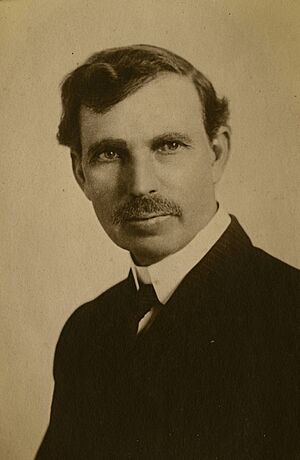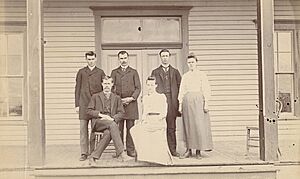History of East Texas Normal College facts for kids
The history of East Texas Normal College (ETNC) tells the story of a school that started small and grew into what is now Texas A&M University–Commerce. It began in 1889 as a private school focused on training teachers. Its founder was William L. Mayo, who led the college until he passed away in 1917.
ETNC first opened in Cooper. But after a fire destroyed its campus in 1894, it moved to Commerce. The college was very popular, especially for teachers who wanted to get or renew their state teaching certificates. Mayo believed in hands-on learning and student participation, not just memorizing facts.
The college's success led to some rivalries with other schools nearby. Even a town called Denison tried to get Mayo to move the college there in 1904. One of its most famous students was Sam Rayburn, who later became a powerful leader in the U.S. government. By 1917, when the State of Texas decided to buy the college, ETNC had taught over 30,000 students. It had trained more public school teachers than any other college in Texas during that time.
Contents
William L. Mayo's Early Life
William L. Mayo was born in Prestonsburg, Kentucky, in 1861. He went to school at Prestonsburg Seminary and Cedar Bluff Academy. He also studied at Central Normal College in Indiana. Mayo worked as a teacher and principal at Cedar Bluff Academy.
In 1886, Mayo moved to Pecan Gap in Delta County, Texas, where his aunt and uncle lived. He started teaching at the local public school there. By 1889, he became the superintendent of the public school system in nearby Cooper. During his time in Pecan Gap, Mayo became known as a strict but caring teacher.
Starting in Cooper
Quick facts for kids
Original Site of East Texas Normal College
Recorded Texas Historic Landmark |
|
|---|---|
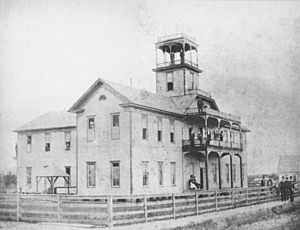
ETNC's original Cooper campus in 1890
|
|
| Location | 600 SE First St., Cooper, Texas |
| Built | 1889 |
| Demolished | 1894 (fire) |
| RTHL # | 6935 |
| Designated RTHL | 1967 |
In 1889, Mayo started ETNC in Cooper. It was a private college for teachers. He bought the land from the public school and worked with the local school system. Mayo promised that ETNC would be "a first-class private college" based on good teaching methods. At first, it was a small school with just one two-story wooden building. Mayo was the president from the start until his death in 1917. In 1891, he married Henrietta "Etta" Booth in Cooper. She was also an ETNC teacher and a talented musician.
The college grew over its first five years. But in July 1894, a fire destroyed its original campus. This made Mayo want to move ETNC. Cooper also didn't have good train service, which was important for a growing school. Mayo looked for a new home for the college. He chose Commerce because it offered him land and $20,000 to rebuild. Commerce also had great train connections to cities like Dallas and Houston.
Moving to Commerce
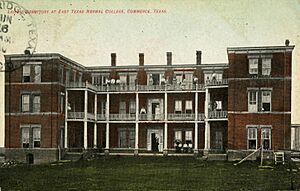
ETNC reopened in Commerce in September 1894. It started with only 35 students in a small rented store. Soon after, they built a two-story classroom building called College Hall. They also built two dormitories for students. When they moved, William and Etta Mayo were the only teachers. Only 10 students followed them from Cooper to Commerce.
In 1899, ETNC opened a large three-story dormitory. It had 80 rooms and could house 160 students. A second, smaller dormitory was built in 1904. The college grew steadily in the 1890s. It had 132 students in 1896 and 212 in 1897. They hired more teachers as they got more money. ETNC also became famous for its "summer normals." These were short courses for teachers who needed to get or renew their state teaching certificates. By 1907, ETNC was known as the best summer school for teachers in Texas.
School Rivalries
The success of William L. Mayo and his college sometimes caused problems with other schools. One big rival was T. Henry Bridges, who ran Henry College in nearby Campbell. Bridges saw Mayo as an outsider because Mayo was from the Northern United States.
The two college presidents argued in local newspapers. On August 24, 1896, Bridges came to Commerce to confront Mayo. He asked Mayo to take back some things he had written. When Mayo refused, Bridges attacked him. This caused a big commotion, and angry ETNC students chased Bridges out of town. Henry College eventually closed down in 1901.
Famous Students
One of ETNC's most famous students was Sam Rayburn. He later became a very important politician and the Speaker of the U.S. House of Representatives. Rayburn spoke highly of the school. He especially liked Mayo's credit system. This system allowed students to attend for free and promise to pay later when they earned money. Rayburn said this helped many young people go to college who couldn't have afforded it otherwise.
ETNC's early success also caught the eye of other towns. In 1904, Denison tried to get Mayo to move the college there. They offered a lot of money to help. It's not known if Mayo seriously thought about moving. But he used the offer to convince Commerce to give the college $30,000 over three years. This money was mostly used to fix up and expand the college buildings.
After moving to Commerce because of a fire, the ETNC campus burned two more times. First, College Hall burned down on January 28, 1907. Then, on January 7, 1911, almost the entire campus burned down. This fire caused about $80,000 in damage. The only building that survived the 1911 fire was "Old Main." This building had opened in February 1908 to replace the first College Hall.
During this time, students at ETNC had many activities. They had student clubs called "literary societies." The college also organized various programs. Sports were popular too, including intramural (in-school) baseball and basketball. They even had an intercollegiate (against other schools) football team, even though Mayo was against it at first.
What Students Learned
The classes at ETNC showed Mayo's ideas about education. He believed in students learning by doing and participating, not just by memorizing. Mayo wanted students to be active in their learning. He would say, "instead of lecturing for him, put him to lecturing you."
In 1900, ETNC offered classes in nine subjects. These included math, philosophy, science, and six languages (English, French, German, Greek, Latin, and Spanish). The school library had about 3,500 books. At that time, tuition cost about $4 per month. Room and board (food and housing) cost about $8.10 per month.
Each school day started with an optional "morning chapel" session. This session often featured motivational talks, sometimes given by Mayo himself. In its early years, most students came to ETNC with only an eighth-grade education. They would spend their first year in a special preparatory program. Then they would enter the "college department." Most popular degrees, like the Bachelor of Science (B.S.), took only three years to complete. A more challenging Bachelor of Arts (A.B.) degree took a full four years.
Becoming a State College
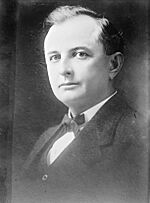
William L. Mayo wanted the State of Texas to buy ETNC. He hoped it would become a state teachers' college. Despite some people being against it, the Texas Legislature voted to buy the college. The state agreed to pay Mayo $80,000 for the school. It was actually worth much more, about $170,000 at the time.
On March 14, 1917, news arrived that the Texas House of Representatives had passed the bill to buy ETNC. On that same day, Mayo sadly died suddenly from a heart attack. Even with Mayo's death, the state still bought the college. Governor James "Pa" Ferguson signed the bill into law on April 4. This transferred ETNC's 50 acres of land and all its buildings to the state. The City of Commerce also donated $40,000 to help renovate the buildings.
From 1889 to 1917, ETNC was a private college. It made money only from tuition fees and a small profit from its dorms. It did not have a large fund of money (an endowment). During this time, it offered six different degree programs. It educated over 30,000 students. It trained more public school teachers than any other college in Texas during that period. The college was especially known for teaching teachers for rural schools. In 1917, almost 2,000 students were enrolled at ETNC.
In 1918, C. E. Evans, the president of another college, said that ETNC did "excellent work for the State." He added that "many of its graduates are today very successful teachers in the public schools."
Images for kids


